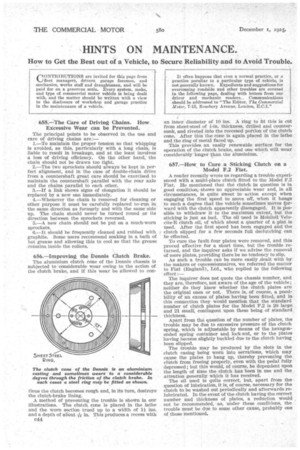• HINTS ON MAINTENANCE.
Page 28

If you've noticed an error in this article please click here to report it so we can fix it.
How to Get the Best out of a Vehicle, to Secure Reliability and to Avoid Trouble.
655.—The Care of Driving Chains. How Excessive Wear can be Prevented.
The principal points to be observed in the use and care of driving chains are :— 1.—To maintain the proper tension so that whipping is avoided, as this, particularly with a long chain, is liable to result in breakage, and at the least involves a loss of driving efficiency. On the other hand, the chain should not be drawn too tight.
2.—The two sprockets should always be kept in perfect alignment, and in the case of double-chain drive from a countershaft great care should be exercised to maintain the countershaft parallel with the rear axle and the chains parallel to each other.
3.-1f a link shows signs of elongation it should be replaced by a new one immediately.
4.—Whenever the chain is removed for cleaning or other purpose it must be carefully replaced tosrun in the same direction as formerly and with the same side up. The chain should never be turned round or its direction between the sprockets reversed.
5.—A new chain should not be put on a much-worn sprockets.
6.—It should be frequently cleaned and rubbed with graphite. Some users recommend soaking In a bath of hot grease and allowing this to cool so that the grease -remains inside the rollers.
656.—Improving the Dennis Clutch Brake.
The aluminium clutch cone of the Dennis chassis is subjected to considerable wear owing to the action of the clutch brake, and if this wear be allowed to con tinue the clutch becomes rough and, in its turn, destroys the clutch-brake lining.
A method of preventing the trouble is shown in our illustrations. The clutch cone is placed in the lathe and the worn section trued up to a width of 1 ins. and a depth of about in. This produces a recess with c44 an inner diameter of 10 ins. A ring to fit this is cut from sheet-steel of /-in. thickness, drilled and countersunk, and riveted into the recessed portion of the clutch cone. After this the cone is again placed in the lathe and the ring of metal faced up.
This provides an easily renewable surface for the operation of the clutch brake, and one which will wear considerably longer than the aluminium. '
657.—How to Cure a Sticking Clutch on a Model F.2 Fiat.
A reader recently wrote us regarding a trouble experienced with a multi-plate clutch fitted to the Model P2 Fiat. He mentioned that th0 clutch in question is in good condition, shows no appreciable wear and, in all circumstances, is quite sweet in, action except when engaging the first speed to move off, when it hangs to such a degree that the vehicle sometimes moves forward with the clutch apparently disengaged. It is tcossible to withdraw it to the maximum extent, but the sticking is just as bad. The oil used is Mohiloil Veincite-Fl clutch oil, of which about a quarter of a pint is used. After the first speed has been engaged and the clutch slipped for a few seconds full declutching can be effected.
To cure the fault four plates were removed, and this proved effective for a short time, but the trouble returned, and the inquirer asks if we advise the removal of more plates, providing there be no tendency to slip.
As such a trouble can be more easily .dealt with by the makers or concessionnaires, we referred the matter to Fiat (Englana), Ltd., who replied to the following effect :—
The inquirer does not quote the chassis number, and they are, therefore, not aware of the age of the vehicle; neither do they know whether the clutch plates are the original ones or not. There is, of course, a possibility of an excess of plates having been fitted, and in this connection they would mention that the standard number of clutch plates for the Model F.2 is 20 large and 21 small, contingent upon these being of standard thickness.
Apart from the question of the number of plates, the trouble may be due to excessive pressure of the clutch spring, which is adjustable by means of the hexagonended spring container and lock-nut, or to the plates having become slightly buckled due to the clutch having been slipped.
The trouble may be produced by the slots in the clutch casing being worn into serrations, which may cause the plates to hang up, thereby preventing the clutch from freeing properly, even with the pedal fully depressed; but this would, of course, be dependent upon the length of time the clutch has been in use and the attention generally which it has received.
The oil used is quite correct, but, apart from the question of lubrication, it is, of course, necessary for the clutch to be washed out periodically and afterwards relubricated. In the event of the clutch having the correct number and thickness of plates, a reduction Would not be recommended, as, 'under these conditions, the trouble must be due to some other cause, probably one of those mentioned.






























